‘Hades’ Henchmen: The Australian Tunnelling Companies and ‘Alphabet Company’: 1916-1919’ by Damien Finlayson
- Home
- World War I Articles
- ‘Hades’ Henchmen: The Australian Tunnelling Companies and ‘Alphabet Company’: 1916-1919’ by Damien Finlayson
(This article was originally published in Stand To! No.83 (August/September 2008) pp.6-13. It is made freely available as key material for the online course The Imperial Western Front created in conjunction with the University of Kent).
Introduction
By mid-1915, ten specially formed British tunnelling companies were already on the Western Front when the idea that Australian miners could also use their skills for the war effort was first mooted. The British companies were working below the front lines at a number of key positions along the British front. The first of these was the loathsome Hill 60 at the southern edge of the Ypres Salient. The progenitor of the British tunnelling companies was an engineering contractor, John Norton- Griffiths. His men had been digging sewer tunnels through heavy clay using a very successful technique called ‘clay-kicking’ and he saw no reason why those skills could not be used successfully in the war. He put a proposal to Secretary of State for War Horatio Kitchener in early 1915 which was pounced upon and the first of twenty-five British tunnelling companies soon came into existence.
By early 1916, the business of tunnelling and mining on the Western Front was highly organised. Mining was so important that a separate and distinct command structure had been developed. At its head, and based at GHQ, was the Inspector of Mines, Brigadier General Robert Harvey RE. Reporting to him were his Controllers of Mines (CoM), one in each of the British Armies and each solely responsible for tunnelling company operations within his army sector. The tunnelling companies reported directly to their relevant army CoM and worked in close co-operation with the front-line infantry commanders garrisoning their mining sectors .
The Short Life of the Australian Mining Corps
The idea that Australian miners could offer that same service in the war, especially as the first contingent of Australian infantry divisions found themselves relying on the sanctuary of an underground existence in the cliffs above ANZAC Cove, came to fruition mostly through the work of two university academics, Professors Ernest Skeats of Melbourne University and William Tannett Edgeworth David of Sydney University.(1) It was Edgeworth David, however, who not only became the driving force in the formation of a special ‘Mining Battalion’, or, to use its grander title the ‘Australian Mining Corps’ (AMC), but also became one of its number. The nucleus of this new Corps - formed in September 1915 and recruited over the next five months - consisted of men with special skills in mining, drilling, surveying and mine engineering. They were redirected from recruitment stations to Sydney where training was carried out at Casula on the western outskirts. Professional mining engineers were directed to the engineering officers’ training school at Moore Park, Sydney.
By early February 1916, the Corps had assembled in Sydney and prepared for departure to the war under the command of Lieutenant Colonel Albert Fewtrell.(2) On 20 February 1916, the contingent of 1,300 officers and men of the AMC boarded HMAT Ulysses at Woolloomooloo, Sydney and steamed through the Heads of Sydney Harbour. The Corps arrived at Marseilles on 5 May and immediately entrained for Hazebrouck, arriving on the morning of 8 May.
When it sailed for Europe, the Corps was under the impression that it would operate as a self contained unit. Once at Hazebrouck, however, the men found the AMC to be inconsistent with the established British mining and tunnelling company hierarchy. The slightly larger than battalion sized AMC contained the 1st, 2nd and 3rd Australian Tunnelling Companies (ATC) along with the HQ Company. Mixed in with it was the nucleus of what later became known officially as the Australian Electrical & Mechanical Mining & Boring Company (AE&MM&B) in 1916.(3) This latter unit became known colloquially, for obvious reasons, as the ‘Alphabet Company’. Almost immediately therefore, the AMC disintegrated into its individual companies. By the end of May, the Corps’ HQ had all but disappeared; its senior officers had left and assumed positions in other Australian units whilst its rankers had filled positions within the individual Australian tunnelling companies or the AE&MM&B, the spin-off unit formed from the technical support arm of the Corps.
The Dispersal
With the exception of the AE&MM&B Company, the ATCs dispersed from Hazebrouck into their respective army and mining sectors in the third week of May 1916. 1st and 2nd ATCs were initially allotted to the Second Army, in whose sector Hazebrouck fell. 1st ATC assumed operations in what had been the sector covered by 171st and 174th Tunnelling Companies RE extending north from the River Lys outside Armentières to Ploegsteert Wood. Two of the company’s four sections were sent north to gain experience with the 181st Tunnelling Company at St Eloi and the 3rd Canadian Tunnelling Company at Hill 60.
2nd ATC took control of shallow mining gallery systems extending southwards from the Lys River to the Cordonnerie Farm Salient outside Fromelles where it relieved 172nd Tunnelling Company RE. 3rd ATC assumed control of the sector of operations of 255th Tunnelling Company RE along the front immediately south of 2nd ATC, extending from the infamous Sugarloaf Salient at Fromelles to the Boar’s Head Salient outside Richebourg l’Avoue. Just prior to the Battle of Fromelles the frontage was shortened with the arrival of the 257th Tunnelling Company RE.
The mining systems were already well established and initially work was mostly confined to mine system maintenance and ‘defensive’ mining, that is, listening and intercepting German mining activity. In addition to mining, the units commenced an activity that would remain a constant task through the war, dugout construction.
Fromelles
The first of the many medals for gallantry won by the Australian tunnelling companies was earned soon after their taking the field. Lieutenant Oliver Woodward of 1st ATC was asked to destroy a troublesome German machine gun firing from the cellar of the ruins of a house, known as the ‘Red House’ in no man’s land just outside the remains of the village of le Touquet.(4) With the assistance of sentries from 10/ Royal West Kents, Lieutenant Woodward won the MC for leading the raid and destroying the post using a mobile charge. It was the first of three MCs won by this officer, an achievement shared by only four other Australian officers in the Great War.(5)
The first major action involving the Australian tunnelling companies was the disastrous Battle of Fromelles on 19 July 1916. Immediately prior to the Australian 32nd Bn (5th Australian Division) attacking from its position in the Cordonnerie Farm Salient, where the front lines were less than 100m apart, 2nd ATC detonated a 520 kg mine below no man’s land. The objective was to use the resulting crater’s earthen rim to shield the attacking Australian infantry from German enfilade fire from the north east.
See Map 1.
Nearby, opposite the Sugarloaf Salient and just to the south in the Red Lamp Salient, 3rd A TC undertook four ‘push-piping’ operations from the front line trenches, to create instantaneous communication trenches for the elements of the attacking British 61st Division. This process involved jacking explosive-filled pipes through the soil just below the surface under no man’s land and detonating them in the last few moments before zero hour. These operations were only partially successful due to the leads becoming damaged by shellfire during the operations, in spite of desperate attempts to reconnect the leads under heavy shell and gun fire. Whilst the infantry suffered terribly in the short battle, especially the Australian 5th Division which was severely mauled, the Australian tunnellers emerged with only a few casualties. Seven men were wounded included Major Lesile Coulter(6) OC 3rd ATC and his 2i/c, Captain Alexander Sanderson.(7)
Defence and Dugouts
For much of the remainder of 1916, the tunnelling companies enjoyed the opportunity of acclimatising to their roles, honing their trench survival skills and their skills in their wartime role as subterranean guardians of the ‘poor bloody infantry’. Most of their time was committed to listening duties in the shallow mining systems, repairing and maintaining mine workings and the construction of dugouts. Defensive mining was undertaken sporadically when German digging threatened. Between 13 August and 1 October 1916, 2nd ATC blew eight small camouflets below no man’s land in the Cordonnerie Salient mine system, all in the vicinity of the 19 July mine crater.(8) Meanwhile along the rest of its sector, 2nd ATC constructed dugouts at Cellar Farm, Wye Farm, Crombalot House, Cowgate Avenue and Lille Post as well as maintaining the mine galleries at Trenches 70, 74 (ANZAC) and 75 (Spion Kop) and the terrible Trench 88 system opposite Frelinghien.
During the autumn of 1916, 1st ATC was engaged in the construction of one of the largest dugouts in the British held sector of the front. ‘The Catacombs’, or as it was known to the tunnellers, the ‘Wallangarra’ dugout, was excavated at Hill 63 near Ploegsteert Wood. The Australian tunnellers worked on it during September and October 1916. Once complete, it accommodated a full battalion of infantry (over 1,000 officers and men). The AE&MM&B Company provided the power plant and fitted it out with 450 lights. The dugout was officially opened on 1 November 1916 by the GOC British Second Army, General Sir Herbert Plumer, with an entourage of staff and lesser generals from his army.
In late August 1916, three more Australian tunnelling companies arrived in France after spending six weeks at Perham Downs camp. 4th, 5th and 6th Australian Tunnelling Companies had been raised in Australia whilst the first three companies were making final plans to embark. The existence of 4th – 6th Companies was to be short lived. Upon their arrival in France they were amalgamated into the three established companies and the AE&MM&B Company. The 4th dissolved into 1st ATC, the 5th into the 2nd and the 6th into the 3rd. This event effectively doubled the establishment of the three older companies. The commanding officers of the recently arrived companies found themselves redundant and they were soon re-assigned to other Australian pioneer or field company units. The influx of men into the established tunnelling companies allowed for the opportunity to filter out men with skills required for the increasingly stretched AE&MM&B Company, and it was at the end of September that this small but influential unit officially came into existence.
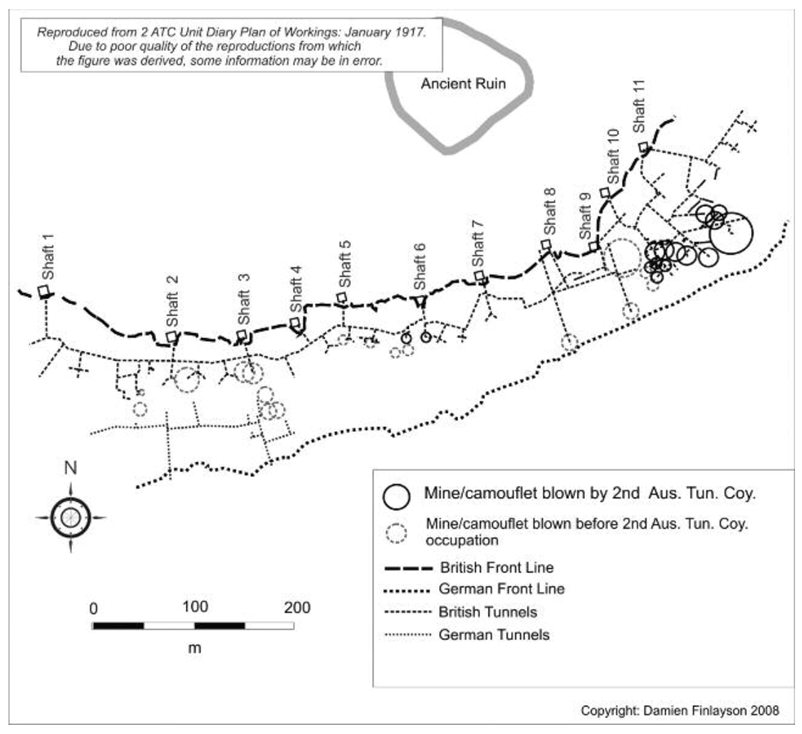
Hill 60 and Messines
In early November 1916 1st ATC replaced 3rd Canadian Tunnelling Company at Hill 60. Headquarters was established at ‘Ridge Camp’ outside Poperinghe and advanced billets were established in the ramparts near the Lille Gate in Ypres. At Hill 60 1st ATC took over the task of protecting two enormous mines placed 30 m below ground by the Canadian tunnellers. Known as the ‘Hill 60’ and ‘Caterpillar’ mines, they were just two of twenty-two massive mines laid, over a period of many months and in great secrecy, by the allied tunnelling companies below the German front line where it dominated the British front along the edge of the Messines Ridge. The mines, with a combined payload of just under one million pounds of high explosive, were placed at intervals in an arc along the western edge of the Messines ridge extending over a distance of 14 km from Hill 60 to Ploegsteert Wood. The three-level mining system at Hill 60 was in poor shape and the Australians set about improving drainage and ventilation as well as embarking on a programme of expansion of the deep mine galleries. The company commenced its tour of duty in one of the most active sections of the front which was subjected to regular, heavy German minenwerfer (trench mortar) bombardments.
In November 1916, 3rd ATC moved south to take over the operations at the Hill 70 mining system at Loos where it relieved the British 258th Tunnelling Company RE. Its camp and headquarters were established at Bracquemont, outside Noeux-les-Mines.
This was to be its home for the next two years. In the early hours of the morning of 27 November 1916, the Germans detonated a deep camouflet in the ‘Black Watch’ mine system, just as the Australian tunnellers were charging their own camouflet. The blast killed twenty sappers and a further nine men were gassed. This event was the greatest single loss of life experienced by an Australian tunnelling company during the whole war. See Map 2.
Mines and Messines
With the arrival of the winter of 1916-1917, the shallow mine systems along 2nd ATC front became waterlogged. Many were allowed to fill and so were abandoned. The mine system at Cordonnerie Farm near Fromelles was also abandoned and in late January 1917, the company moved its operations northward to ‘The Bluff’ and the ‘Spoilbank’ where the Ypres-Comines Canal cuts through the Messines Ridge. Here, the company undertook listening duties and amongst other works, assisted 1st ATC, its neighbouring tunnelling company, with dugout construction. Like 1st ATC, 2nd ATC established its HQ outside Poperinge, at ‘Moonta Camp’.
On Easter Monday, April 9, 1917 the Germans embarked on one of their largest raids of 1917 at Hill 60 for the purpose of locating and destroying mine shafts. The attack resulted in the permanent loss of a portion of the shallow mine system and five Australian tunnellers were captured. Importantly, the Germans recovered a cutting of ‘blue clay’ the deep Ypresian clay in which the massive mines were placed, thereby alerting them that the British had gone deeper than they thought. This propelled them to search for the deep mines and it almost resulted in their discovery.
Easter Monday 1917 was also the start of the Battle of Arras. The hinge point between the British front line at the start of the battle and that which settled down afterwards lay directly over 3rd ATC’s Number 1 mine shaft at Loos. Whilst the company was not required to use its mining skills for the battle, its men were involved in carrying ammunition to front line British units and repairing roads across the old no man’s land. One road, leading into the village of Liévin is named ‘Australian Road’ on official British trench maps of the time, in recognition of the work of 3rd ATC during the battle.
Meanwhile, and ironically, 1st ATC suffered its largest single day of casualties at Hill 60 on 25 April. Three officers and nine other ranks were killed instantly when an explosion ripped through the front line officers’ dugout and tore through an adjoining one.
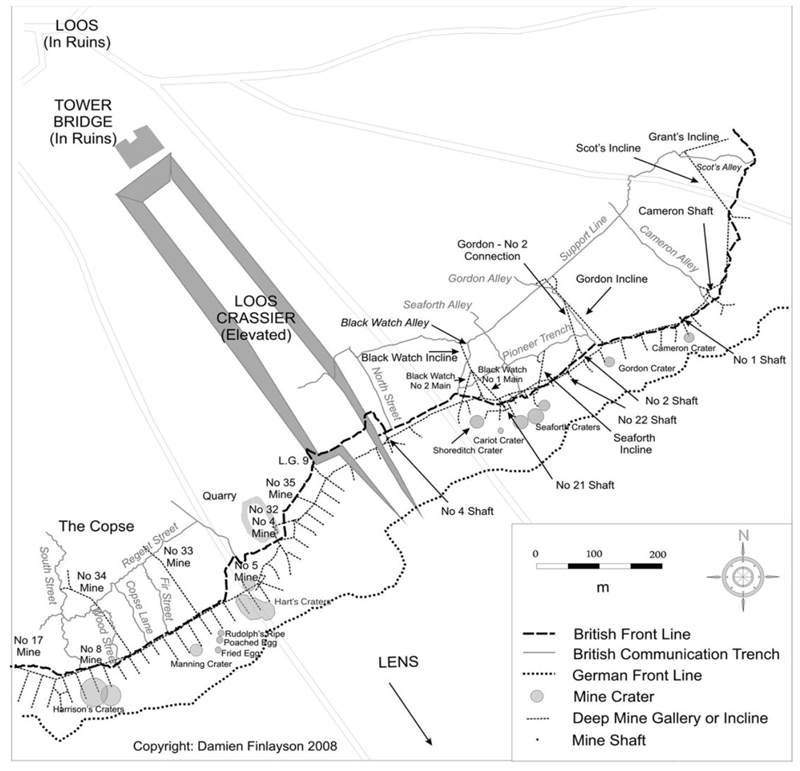
In the pre-dawn of 7 June 1917, the culmination of almost eighteen months of exhausting work by tens of thousands of British, Australian and Canadian tunnellers came to fruition with the detonation of nineteen of the massive mines that had been buried below the German front lies on the Messines Ridge. Within the span of just three minutes, 425 metric tons of high explosives vaporised German positions on the crest of the ridge. Captain Oliver Woodward of 1st ATC threw the two electric switches for the northernmost two mines – Hill 60 and The Caterpillar - and 56 metric tons of explosives went up in unison. Such was the overwhelming effect of the mines that losses in the attacking infantry were relatively light; many were able to advance across and through the German lines with little opposition.
The British victory that morning was arguably the most convincing until that point of the war. Unfortunately, the successes of the morning were later squandered as the Germans recovered and responded. In spite of this, the concept of the mines of Messines was without doubt one of the most bold and audacious ideas adopted and implemented by the British high command in the war and it is certainly a lasting tribute to the men who toiled, lived and died underground in order to ensure its success.
‘Operation Hush’
Soon after the mines of Messines were blown, 1st ATC commenced dugout construction and road building in the Messines/Wytschaete area and established its HQ in a new camp purpose built by its own men at Dranoutre. One of the dugout complexes was in the Spanbroekmolen Mine Crater which had been created on 7 June.
At the end of June 2nd ATC transferred to the Belgian Coast to prepare for ‘Operation Hush’. This was the proposed British coastal landing behind German lines near Middelkerke to knock out the German U-boat ports at Ostend and Zeebrugge then roll back the German line. The company was one of half a dozen Allied tunnelling companies sent to the coast with the British XV Corps. Its new sector was the seaside village of Nieuport Bains where the Yser Canal flows into the North Sea. The focus of the Australian tunnellers’ attention were the dunes where the two front lines met on the northern side of the Yser canal. Access to the front was via three pontoon bridges near the mouth of the canal. Mines were to be placed below two large dunes on the German front line and blown at the start of the operation.
On 10 July, however, the Germans, recognising that preparations for a British offensive were underway, launched their own attack aided by the first use of mustard gas. By the end of the day, the British had suffered over 3,000 casualties, mostly prisoners. Early in the day the three pontoon bridges at Nieuport Bains were destroyed by artillery, trapping all the men on the northern side of the canal. Forty-one tunnellers and one officer from 2nd ATC were infantry labour from 1/Black Watch and 1/South Wales Borderers. Only a handful of tunnellers were able to escape by swimming across the canal.
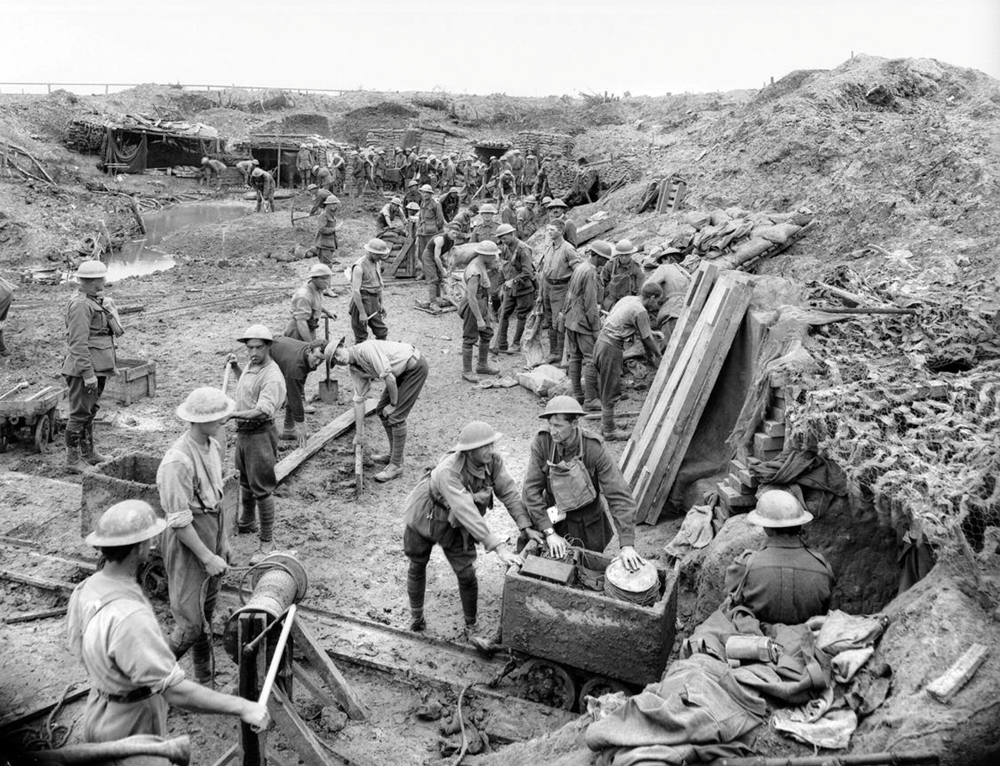

Losses at Loos
Meanwhile 3rd ATC was experiencing its own dramas at Loos. On 28 June 1917, a party from 3rd ATC accompanied a two company raiding party (one each from 2/Durham Light Infantry and 11/Essex) from 18 Brigade. The tunnellers’ task was to locate and destroy German mine shafts and dugouts. The tunnellers were led by Captain Alexander Sanderson but Major Leslie Coulter DSO, the company’s commanding officer, elected to join the raid at the last moment. The raid itself was successful - three German mine shaft heads and two deep dugouts were destroyed - but Major Coulter and his batman were killed by sniper fire. From that time on, Captain (later Major) Alex Sanderson assumed command of 3rd ATC.
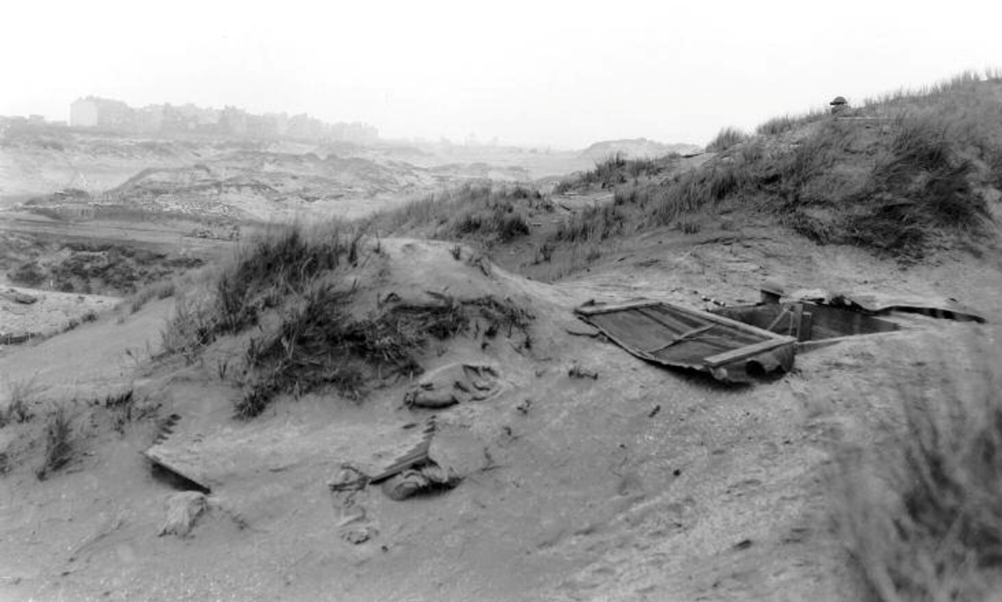
Two weeks later the German miners at Hill 70 blew what was to be one of their last mines of the war along the British sector of the front. The resulting crater was named Coulter Crater in honour of the respected and recently deceased Australian tunnelling officer. In response, the Australian tunnellers went on the offensive and within days had broken into the German mining system, capturing 235m of opposing galleries. Finally, on 27 July 1917, the Australian tunnellers blew one of their last ‘maximum’ camouflet. Two weeks later, the Canadian Corps captured Hill 70 and pushed the German line back down the eastern slope of the hill. Two detachments of tunnellers accompanied the Canadian infantry, locating and checking captured dugouts and posts.
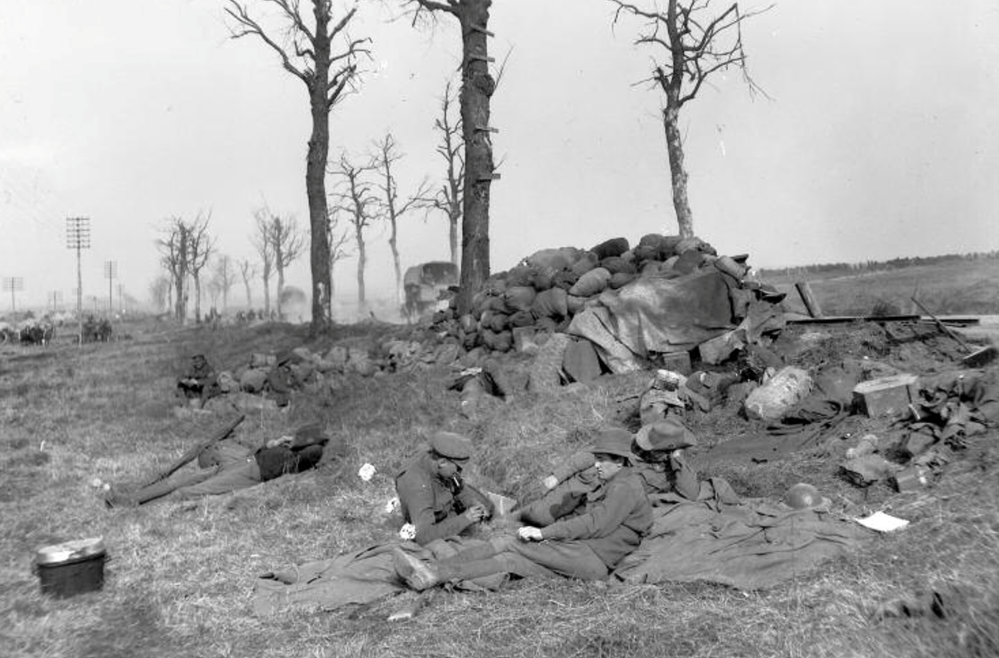
In the first week of September 1st ATC was transferred to the Ypres Salient to assist in the preparations for the Battle of the Menin Road on the front to be occupied by I ANZAC Corps. The company initially focused on expanding the deep dugout system in the Hooge Crater. On 19 September, the eve of the battle, the company handed over the dugout system to the headquarters of 2 and 3 Brigades of 1st Australian Division.
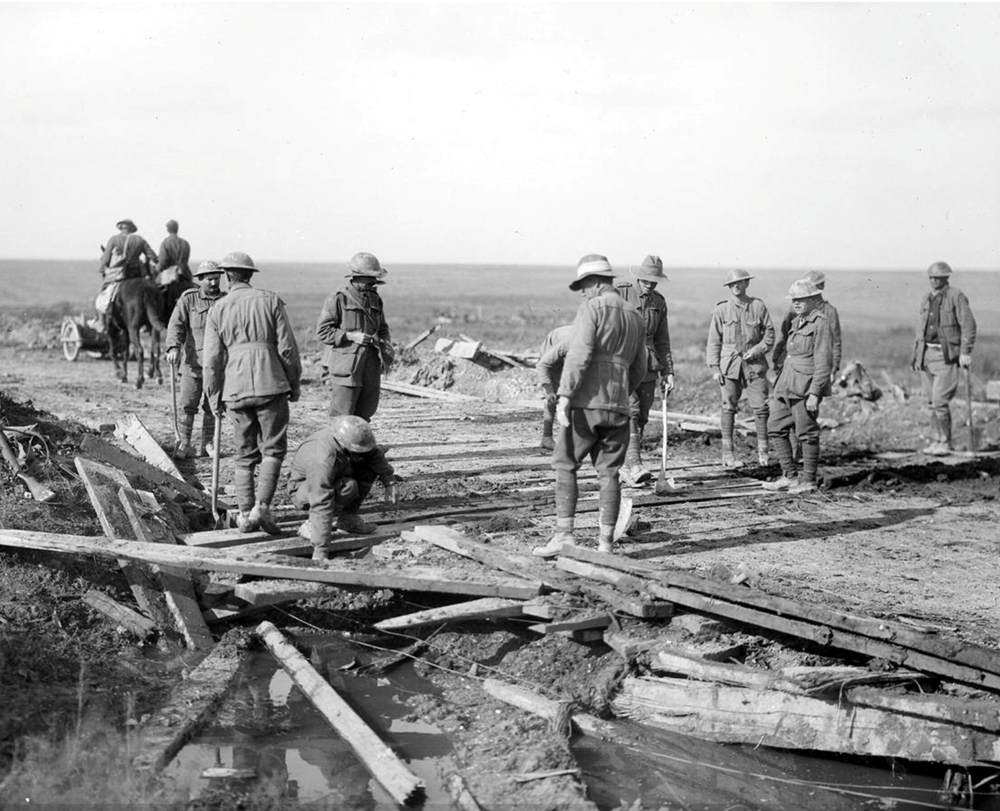
After the Battle of the Menin Road, the company assisted in clearing dugouts during the Battle of Polygon Wood and commenced constructing dugouts across the ground gradually being won by the infantry as they slogged towards Passchendaele. A group of sappers worked for two days to seal the eastern entrances to the old German dugout system that lay within the ‘Butte’ in Polygon Wood after its capture by the 5th Australian Division.
Through the autumn and winter of 1917, the Australian tunnelling companies were mostly engaged in dugout construction work. In the Ypres Salient, 1st ATC was involved in the construction of dugouts at the following locations: Halfway House, Birr Cross Road, Cambridge Road, Westhoek, Kit and Kat, ANZAC, Muhle, Zonnebeke Church, Cemetery North and South and Dash near Tyne Cot. The AE&MM&B Company was also engaged in installing and maintaining power plants in the salient, capable of generating 51.5 kW to 900 lights in a number of advanced dugout systems including; Tor Top, Railway Wood, Hill Top Farm and Lancashire Farm. Later, the unit also successfully provided power and lighting to the Menin Road advanced dressing station operated by the 2/2nd East Lancashire Field Ambulance.
Following the capture of Hill 70 at Loos, 3rd ATC’s operational front was extended northwards to cover the extensive, interconnected tunnel complexes opposite the villages of Hulluch and Cité St Elie on the southern flank of the Hohenzollern Redoubt. Here, the company embarked on an extended period of dugout construction and maintenance in the tunnels in the sector. During winter 1917, 3rd ATC started one of its largest tunnel construction projects, what later became known as the Hythe Tunnel, connecting the old front line mine gallery system with the new front line trenches lying on the eastern slopes of Hill 70.
From coast to Cambrai
As winter set in, 2nd ATC was also on the move to join the British Third Army on the Cambrai front, leaving the Nieuport Bains sector on 18 November 1917. The company left behind dugouts, machine gun posts and infantry subways totalling 4,835 linear metres of tunnels constructed entirely in the sands of the dunes between Nieuport Bains and Oost Dunkerke Bains. Its crowning achievement, however, was the construction of an infantry subway running a distance 1,190 m below the foreshore buildings at Nieuport Bains and ending just shy of the Yser Canal.
The company arrived in the shattered remains of Havrincourt Wood on 26 November where it established camp. Snow was falling on Cambrai as the men immediately set to work repairing roads and digging support lines for the British divisions then in the thick of the battle.
Through the winter months, 2nd ATC was engaged on an ambitious construction programme across the entire Cambrai Salient, mostly dugouts and gun emplacements for Royal Artillery batteries and a series of advanced battalion headquarters in the V Corps area. Other companies thus employed were 174th, 175th, 181st, 252nd and 257th Tunnelling Companies RE. By Christmas, a camp had been constructed for the company at Ypres and one of the more unusual demands placed on the company included converting local village catacombs into accommodation and infantry subways.
Evidence that a German offensive was in the offing became evident to the men of 2nd ATC during February 1918. The Germans embarked on a softening up campaign and the number of high explosive and mustard gas shells being fired into the Cambrai Salient increased noticeably towards the end of the month. The impact on 2nd ATC, many of whose men were working in exposed conditions right across the salient, was dramatic. On 25 and 26 February, fifty-one Australian tunnellers were hospitalised with gas poisoning. Over the weeks leading up to 21 March 1918, the intensity of the German artillery fire into the salient increased further with a proportionate increase in the use of mustard gas shells. Between 12 and 15 March 1918, it was estimated that around 110,000 gas shells were fired into the V Corps area. On 12 March whilst working near the village of Trescault, seventy-six men from No. 3 section and fifty-four attached infantry became gas shell casualties. By the eve of the German offensive at Cambrai, almost a third of 2nd A TC establishment had been hospitalised through gas poisoning.
Retirement
March 1918 and the brunt of the offensive along the British sector was felt by the divisions holding the Cambrai Salient. By the following day, the overwhelming number of German troops overran the British defences. 2nd ATC was one of the many ‘British’ units caught up in the retirement. At 4:15 am on 23 March the company was ordered to evacuate. Over the next five days, it marched westwards across the old Somme battlefield to Querrieu via Rocquigny, Longueval, Pozières, Aveluy and Mailly-Maillet.
At Querrieu, the weary company was thrown into constructing lines of defensive works in the southern sector of what was known as the ‘GHQ Defence Line’ between the Ancre River and the Amiens - Albert road. As the Australian tunnellers set to work, the 3rd and 4th Australian Infantry Divisions were arriving in the same sector after being rushed south to assist with the defence of Amiens. It was the first time in fifteen months that 2nd ATC had worked alongside an Australian infantry division. The company was also assigned the job of wiring for demolition and guarding all the bridges over the Ancre and Somme rivers in the corps area, including those in Amiens. The explosive charges were only removed from all the bridges once the Allied advance commenced in August.
Whilst the British retirement across the Somme battlefields was still occurring, 1st ATC in the Ypres Salient was, at short notice, ordered to proceed southward. It too was given the task of constructing a new line of trenches, this time along the northern portion of the GHQ Defence Line, in the British VI Corps sector. On 29 March, it arrived at Saulty and immediately set to work digging six km of new trenches. The company then commenced a phase of constructing machine gun emplacements across the rear of the Third Army area which then occupied it for the following two months.
On 9 April 1918, the second thrust of the German spring offensive was made against the allied line near Fromelles. The 2nd Portuguese Division bore the brunt of the initial onslaught and soon crumbled allowing the Germans to roll back the British lines towards Armentières in the north and Givenchy on the La Bassée Canal to the south. At the time, a detachment of men from 3rd ATC was constructing machine gun positions in and around Armentières. Such was the seriousness of the situation and the ensuing confusion which followed, that the detachment was placed in the front line to act as infantry alongside elements of the British 34th Division outside Erquinghem-sur-Lys. It was here that the detachment’s commanding officer, Lieutenant Neil Campbell was killed in action after going to seek confirmation of an order for his men to retire. Over the course of the following five days, the unit fell back through Armentières to Strazeele, at times taking up rear-guard positions with 12/Suffolk Regiment. By that time, the 1st Australian Division had arrived as reinforcements and had established its headquarters in nearby Pradelles. The exhausted tunnellers were transferred to the 1st Division’s engineers and contact with the 3rd ATC headquarters was re-established.
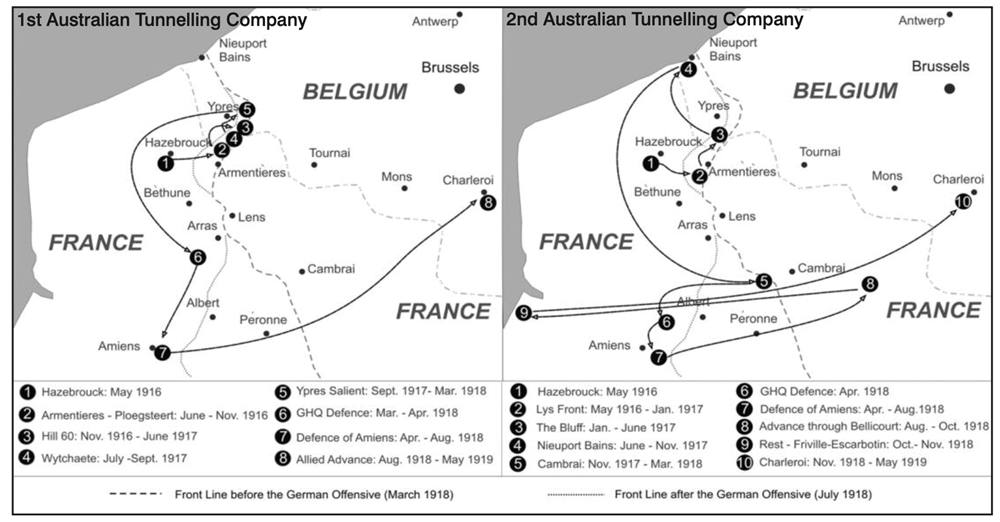
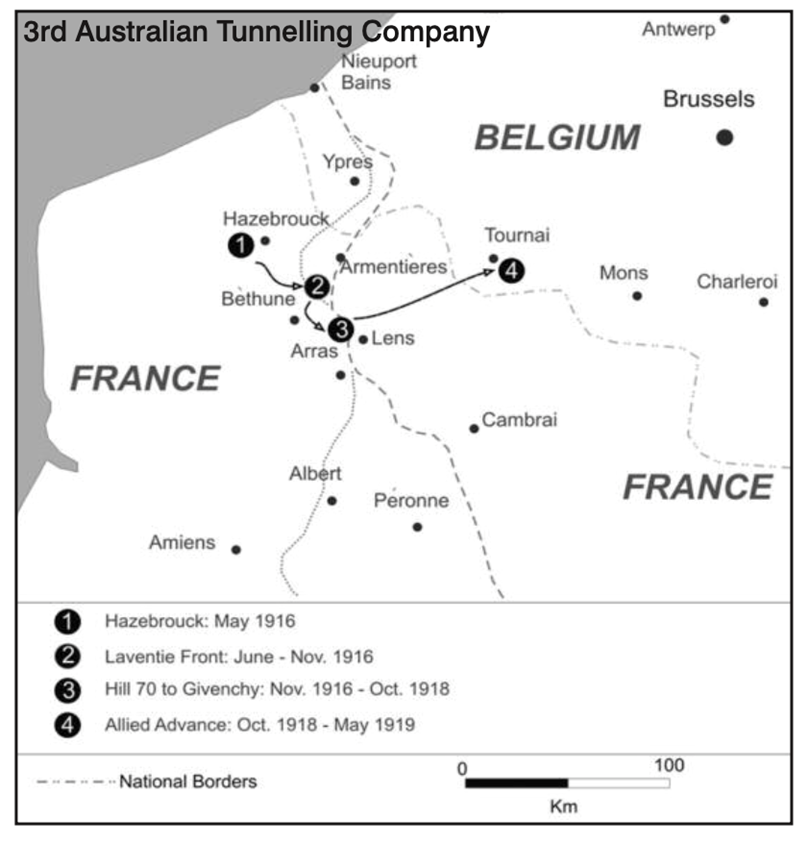
The southern hinge of the German offensive on the Lys front fell at Givenchy on the La Bassée canal. The underground power supply, lighting and ventilation to a series of fortified ‘keeps’ connected by long tunnels was maintained by sappers from the ubiquitous AE&MM&B Coy. The German advance saw the British positions at Givenchy overrun on 18 April but the village was reclaimed the following day by the British 1st Division after intense fighting. Five men from the AE&MM&B Coy who struggled to keep the tunnels free of water during the battle were taken prisoner. The company suffered further disruption with the German advance towards Hazebrouck, causing it to abandon its HQ and workshops hastily. It was re-established along with 300 tons of equipment at Assinghem, south-west of St Omer where it remained for five months until a move to Marœuil near Arras during the Allied advance.
In the sector south of Givenchy, the 3rd ATC suffered the effects of the German attack on the Lys front when the area from the La Bassée Canal to Vermelles was subjected to days of unrelenting gas shelling. Over the three days commencing 8 April, the 3rd ATC suffered forty-three cases of gas shell poisoning from the company’s two sections working near Vermelles.
During May, June and July 1918, 1st and 2nd ATCs continued with defensive emplacements on and around the GHQ Defence Line. By the end of May the Australian Corps had come into formation under General Monash and held the front between the Somme and Ancre Rivers. At the end of June, 1st ATC moved down to billets at Rivery, a suburb of Amiens and for the first time in over twelve months the two Australian tunnelling companies, although not working directly alongside each other, were at least working within a few kilometres of each other. They would continue to do so for the following four months.
Allied thrust
On 8 August 1918, the Allied thrust against the Germans commenced. The British Fourth Army was the first to move. It straddled the Somme River and comprised the Canadian, Australian and British III Corps. Four days prior to the advance, 2nd ATC HQ moved to Bois de l’Abbe outside Villers-Bretonneux. The two tunnelling companies provided parties of sappers to accompany the advancing Australian divisional engineers to inspect the suitability of captured dugouts as HQ dugouts and check them for booby traps. The two parties each from 2nd ATC were assigned to field companies of the 5th and 2nd Australian Divisions. Similarly, four parties of tunnellers from 1st ATC advanced with the 3rd and 4th Australian Divisions.
By 19 September, the Fourth Army faced the Hindenburg Line with the Australian Corps facing Bellicourt. On 24 September, 27th and 30th Division of the American II Corps joined the Australians to form a joint army corps. The joint Australian-American Corps had a two division attack frontage. On 29 September, the Americans led the assault on the Hindenburg Line across the corps’ front with 3rd and 5th Australian Divisions in support. The 1st and 2nd ATCs were to maintain forward roads - the main roads being codenamed, ‘Black’, ‘Blue’, ‘Red’ and ‘Yellow’. Facing the distant village of Bony was the 27th American Division with 3rd Australian Division in support. Here the 1st ATC had the responsibility of clearing and maintaining the ‘Yellow’ and ‘Blue’ roads. On the front of 30th American and 5th Australian Divisions, 2nd ATC was responsible for the ‘Black’ and ‘Red’ roads that passed through and around Bellicourt. A quarter of the Military Crosses won by 1st ATC and half of those won by 2nd ATC were for actions on 29 September 1918. Over 29 and 30 September, the two Australian tunnelling companies suffered seventy-three casualties including six men killed or died of wounds.
The last action of the Australian infantry took place with the capture of Montbrehain on 5 October. The Australian Corps was then withdrawn and the Americans took control of the corps area. The two Australian tunnelling companies continued to move eastward and worked with the Americans until 16 October when 2nd ATC left for a rest camp at Friville- Escarbotin on the French coast. 1st ATC, however, chose to remain on duty. By 21 October the Germans on the Fourth Army front had been pushed back to the Sambre-Oise canal and the American II Corps was replaced by the British IX Corps. On 4 November, the canal was stormed by the British 1st Division. At the locks outside the village of Rejet-le-Beaulieu, a party of ninety-eight officers and sappers under Captain Oliver Woodward had the task of erecting a heavy vehicle bridge over the canal in the hours following the British attack. This was achieved at a cost of four men killed and five wounded. The action at Rejet-le-Beaulieu by 1st ATC on 4 November 1918 was the last involving an Australian army unit in the war. After the crossing of the canal, 1st ATC continued to pursue the retreating Germans with the British IX Corps and it was still in action on 11 November when the Armistice was announced as the British XIII Corps crossed the Belgian border near Sivry.
Advance in the north
Further north, on 25 September 1918, the first signs that the Germans were retreating became apparent in front of the British I Corps (Fifth Army). In anticipation of a German retreat, 3rd ATC assembled six specially trained investigation parties to accompany the vanguard British divisions on the I Corps front to search for booby traps, mines, explosives and to inspect dugouts, buildings and other captured infrastructure. By 4 October, La Bassée had been abandoned by the enemy. Soon the British 15th (Scottish) and 16th (Irish) Divisions, together with their embedded Australian tunneller investigation parties, were in hot pursuit.
The British crossed Haute Deule Canal at Pont a Maudit (9) and Meurchin Bridges built by 3rd ATC. By 23 October they were in Belgian territory looking across the flooded River Scheldt just south of Tournai. On 9 November, the Schedlt was crossed and the British advanced rapidly. By the time the Armistice was announced two days later they had covered over twenty kilometres. Men from the tunnelling companies investigation parties were by this time almost fifty kms in advance of their company headquarters. Thus, the war ended for 3rd ATC having spent its entire Tour of Duty in France without a rest and without serving with another Australian unit.
After the Armistice, the Australian tunnelling companies initially concentrated on locating and rendering harmless abandoned ammunition, explosives, booby traps and mines in the areas around Tournai (3rd ATC) and Charleroi (1st and 2nd ATCs). They then turned their attention to repairing local infrastructure, mostly bridges in their respective areas, until the process of repatriation whittled away then numbers. By June 1919, all except those men who had applied to remain in France or Belgium on non-military employment had left the Western Front and were either in England or en-route for Australia and the units ceased to exist.
Conclusion
Of approximately 4,500 men who served with the three Australian tunnelling companies and the AE&MM&B Company between 1916 and 1919, 322 lost their lives whilst on the establishment of those units. (10)
Honours awarded to the daughter units of the AMC were: OBE - 1, MBE -2, DSO-6, DCM-29, (11), MC-46(12), MM-77, MSM-27, Foreign Awards-10, MiD-48.(13)
The Australian tunnelling companies and the AE&MM&B Company had unique roles in Australian military history. They reported to a British chain of command on operational matters yet their administration was via the AIF HQ. They worked without rest for extended periods of time in the same sector of the front line yet worked all along their assigned sectors. They worked more closely with English, Scottish, Welsh, Irish and Canadian Infantry units and the compatriots and with the exception of the Somme Offensive, one or more played a role in all the major allied offensives on the Western Front between July 1916 and the Armistice. They were subjected to the same terrors of front line trench warfare as the infantry yet they compounded this by entering a world of terror underground, a form of warfare about which the Infantry was largely ignorant and the civilian population was totally ignorant. They could quite rightly have claimed to be the true Australian ‘diggers’ of the Great War.(14)
The above is an original piece based on Damien Finlayson’s forthcoming book Crumps and Camouflets on the Australian Tunnelling Companies and Alphabet Company during the Great War.
References
|
(1) |
Lieutenant Colonel Sir William Tannett Edgeworth David KBE, CMG, DSO, AMC HQ 1915-1916. Attached GHQ 1916-1919. University Professor of Sydney, New South Wales. Born St Fagans, Wales 1858. Died 1934. |
|
(2) |
Lieutenant Colonel ALbert Fewtreel DSO. Commanded AMC 1916-1916. Commanded ANZA Light Railways 1916-1917. Civil Engineer of Neutral Bay, Sydney/ Born Chester, England 1885. Served as Maj Gen in the Second World War. Died 1950. |
|
(3) |
In terms of designation - Charles Bean, were by this time almost fifty km in advance of the author of the Australian official their company headquarters. Thus, the war histories, uses the designations: 1st, 2nd ended for 3rd ATC having spent its entire tour & 3rd Tun. Coy. I have inserted the word of duty in France without a rest and without ‘Australian’ to avoid confusion with the serving with another Australian unit. British and Canadian tunnelling companies. |
|
(4) |
Captain Oliver Holmes Woodward MC and two bars, 1st ATC. Mining Engineer and metallurgist of Mt Morgan, Queensland. Born Tenterfield, Australia, 1885. Died 1966. |
|
(5) |
Australian War Memorial On-line database https://www.awm.gov.au/honours/honour |
|
(6) |
Major Leslie Coulter DSO. Commanded 3rd ATC 196-June 1917. Mining Engineer of Claremont, Western Australia, 1881. Died 28 June 1917. |
|
(7) |
Major Alexander Sanderson DSO, MC and bar, AMC HQ 196. Commanded 3rd ATC June 1917-1919. Civil and Mining Engineer of Claremont, Western Australia. Born Oamaru, New Zealand, 1881. Died date unknown. |
|
(8) |
An explosive charge designed to destroy enemy underground workings, without forming a crate at ground surface. |
|
(9) |
The Hopkins-type bridge constructed by 3rd ATC at Pont a Maudit was completed in seven days. It was officially opened 31 October 1918 by I Corps GOC Lieutenant General Sir Arthur Holland. He took the occasion to express his thanks for the efforts of the Australians not only for the bridge but for their work in his corps’ area over the many preceding months leading up to October 1918. |
|
(10) |
Further lives were lost after transferring to other Australian units. |
|
(11) |
Including bar to Corporal 1306 Jack Nancarrow of the AE&MMB Coy for action at Givenchy in April 1918. |
|
(12) |
Including bar to Major Alexander Sanderson DSO, and two bars to Captain Oliver Woodlward MC. |
|
(13) |
Awarded to men whilst on the establishment of the relevant units. |
|
(14) |
The primary sources of information in this article derive from: AWM 4 Series 16/1/16/4 : War Diaries of the AE&MM&B Coy (Jan-June 1918) and 1st - 3rd ATCs respectively, Military Operations: France & Belgium Vols. 1916-1918 by J E Edmonds, C.Falls & W.Miles, Official History of Australia in the War 191401919, Vols II-VI by C.B.E. Bean, Australian War Memorial on-line biographical databases, National Archives of Australian on-line service records (B2455 Series). |





